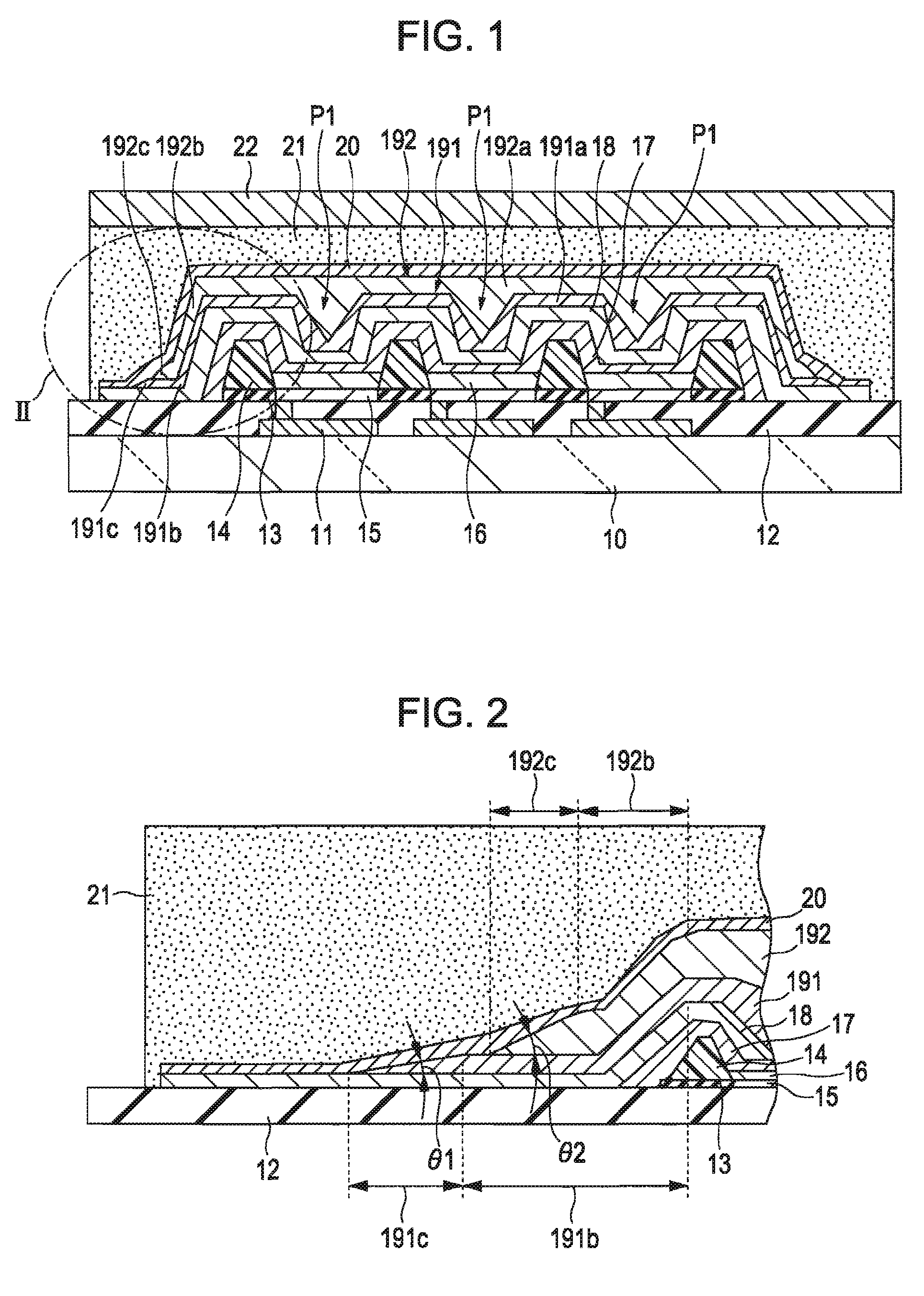Light-emitting device for sealing light-emitting elements and electronic apparatus
a technology of light-emitting elements and electronic devices, which is applied in the direction of discharge tubes/lamp details, discharge tubes luminescnet screens, electric discharge lamps, etc., can solve the problems of cracks or peeling of gas barrier layers, cracks due to stress concentration, and sealing properties, etc., to improve the sealing properties of plurality, small covering regions, and large covering regions
- Summary
- Abstract
- Description
- Claims
- Application Information
AI Technical Summary
Benefits of technology
Problems solved by technology
Method used
Image
Examples
first embodiment
[0036]An organic EL panel (light-emitting device) according to a first embodiment of the invention is a full color panel using a polymer organic EL material, which will be described later. The organic EL panel has an organic EL element emitting a red light component, an organic EL element emitting a green light component, and an organic EL element emitting a blue light component that are arranged side by side and is capable of performing full color display. The organic EL panel is a top emission type in which light from the organic EL element is emitted from the opposite side of a main substrate.
Structure
[0037]FIG. 1 is a cross-sectional view of the organic EL panel. FIG. 2 is an enlarged cross-sectional view illustrating a portion A of the organic EL panel. The organic EL panel includes a flat main substrate 10. The main substrate 10 is formed of, for example, glass or plastic, and has a plurality of organic EL elements P1 formed on the upper surface thereof. The organic EL element...
second embodiment
[0064]An organic EL panel according to a second embodiment of the invention is similar to the organic EL panel according the first embodiment except for the structure of an organic buffer layer.
[0065]FIG. 3 is a cross-sectional view of the organic EL panel. FIG. 4 is an enlarged cross-sectional view illustrating a portion B of the organic EL panel. In the organic EL panel, a first organic buffer layer 193 is formed on a cathode protecting layer 18 so as to overlap a plurality of EL elements P1. A second organic buffer layer 194 is formed on the first organic buffer layer 193 so as to cover the first organic buffer layer 193. A gas barrier layer 20 is formed on the cathode protecting layer 18, the first organic buffer layer 193, and the second organic buffer layer 194 so as to cover both the organic buffer layers.
[0066]The first organic buffer layer 193 and the second organic buffer layer 194 are provided to improve the flatness and adhesion of the gas barrier layer 20 and to buffer ...
third embodiment
[0075]The structure of an organic buffer layer of an organic EL panel according to a third embodiment of the invention is the same as that of the organic buffer layer of the organic EL panel according to the second embodiment. However, the organic EL panel according to the third embodiment is a full color panel using a low-molecular-weight-based organic EL material, which will be described later, and can perform full color display using organic EL elements emitting white light and color filters.
Structure
[0076]FIG. 5 is a cross-sectional view illustrating the organic EL panel, and FIG. 6 is an enlarged cross-sectional view illustrating a portion C of the organic EL panel. The organic EL panel includes a flat main substrate 30. The main substrate 30 is formed of glass or plastic, and a plurality of organic EL elements P2 are formed on the main substrate 30. The organic EL element P2 is an element that emits white light, has an organic light-emitting layer 37 formed of a low-molecular-...
PUM
 Login to View More
Login to View More Abstract
Description
Claims
Application Information
 Login to View More
Login to View More - R&D
- Intellectual Property
- Life Sciences
- Materials
- Tech Scout
- Unparalleled Data Quality
- Higher Quality Content
- 60% Fewer Hallucinations
Browse by: Latest US Patents, China's latest patents, Technical Efficacy Thesaurus, Application Domain, Technology Topic, Popular Technical Reports.
© 2025 PatSnap. All rights reserved.Legal|Privacy policy|Modern Slavery Act Transparency Statement|Sitemap|About US| Contact US: help@patsnap.com



